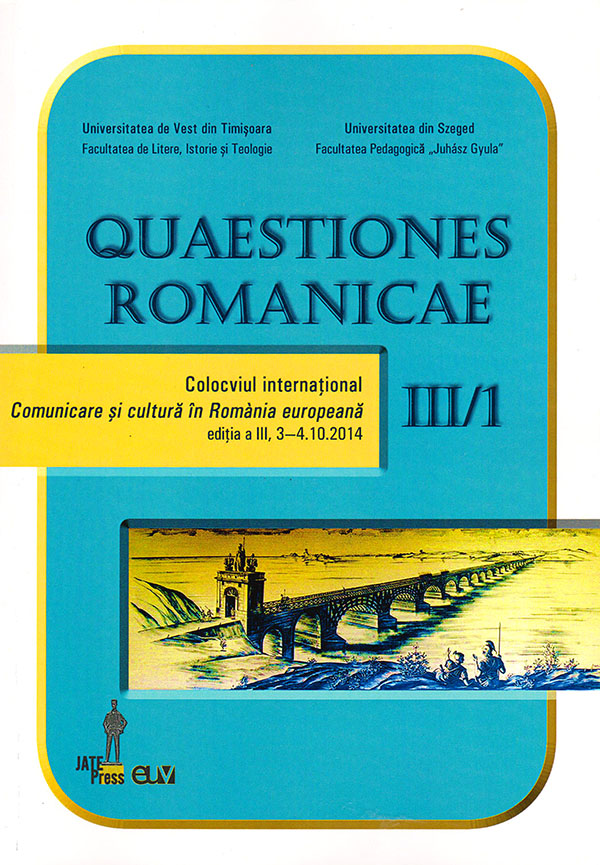Sfântul Ioan Cassian, punte teologică între Răsărit şi Apus
Abstract: (Saint John Cassian, a Theologian Bridge between East and West). Saint John Cassian a highly prestigious theologian of his time, served both the Eastern Church to which he belonged and the Western Church as well – by virtue of the fact that he lived in Rome for a while and subsequently in Marseilles, in Southern Gaul. His valuable contribution to the organization of monastic life in the West, particularly in Gaul and Spain, has been unanimously unfolded, and the depth and beauty of his patristic writings equally appreciated in the East and West. As for his saintliness, no one has ever disputed it over the centuries. Since Cassian needed to protect himself against possible accusations of heresy, his respect and affection for his great predecessor, Origen, were not openly displayed in his writings, but only deduced from reading between the lines. We also know that the hermitic erudite Evagrius Ponticus was a source of inspiration for John Cassian, causing him to elaborate some of his ideas related to the eight basic temptations of monastic life, expounded in his treatise entitled De octo vitiosis cogitationibus. Meeting Saint John Chrysostom, a heroic figure of the Eastern Church, whom Cassian acknowledged as his spiritual father through and through, constituted a crucial turning point in his spiritual life. St John Chrysostom, the Patriarch of Constantinople, ordained Cassian as a deacon in Constantinople, which made the Scythian monk feel particularly close to the inhabitants of that city. In 405, the deacon John Cassian was sent to Pope Innocent I in Rome to expound on with the circumstances affecting St John Chrysostom’s situation. Although his plea was not successful, he settled in Rome where he was ordained as a hieromonk in 415. Having reached spiritual maturity, he became concerned with turning his rich spiritual experience to good account. Consequently, he decided to make known the fullness of Eastern spirituality to the Western world; from Rome, he travelled to Gaul, making Marseilles his home for the remainder of his life. His travelling was approaching the end. Cassian’s contribution to outlining a new literary genre in the Christian letters, i.e., the Paterikon, which originated in his Conferences, is worth mentioning. His writings marked the beginning of monastic literature drawn up in Latin, which established St John Cassian as a representative of Latin Orthodoxy. His writings abound in useful, edifying advice likely to improve the minds and characters of all Christian believers.
Keywords: Latin Church, Saint John Cassian, orthodox monk, ecumenical.
Rezumat: Sfântul Ioan Cassian, a fost un teolog de mare prestigiu al timpului său, care a slujit deopotrivă Biserica de Răsărit, din care provenea, dar şi cea de Apus, din moment ce a trăit un timp la Roma, apoi în sudul Galiei la Marsilia. Contribuţia sa la organizarea vieţii monahale din Apus (Galia şi Spania) a fost unanim recunoscută; bogăţia şi frumuseţea scrierilor sale, de esenţă patristică, sunt deopotrivă apreciate de Apus şi Răsărit, iar sfinţenia sa, de-a lungul anilor, de nimeni contestată. Respectul şi dragostea lui Cassian faţă de Origen, acest precursor măreţ, răzbat printre rânduri din lucrările sale, dar direct este evitată orice mărturie de fidelitate din nevoia de protecţie a propriei opere contra unor eventuale învinuiri de erezie. Despre învăţatul eremit Evagrie ştim că i-a inspirat lui Cassian unele dintre ideile legate de cele opt tentaţii de bază din viaţa călugărului prin lucrarea De octo vitiosis cogitationibus. Un moment crucial în pregătirea sa duhovnicească l-a constituit întâlnirea cu Sfântul Ioan Gură de Aur pe care îl va socoti până la capăt părintele său spiritual. Acest erou al Bisericii lui Hristos l-a hirotonit diacon pe Cassian la Constantinopol, drept care călugărul scit se va simţi foarte apropiat de locuitorii acestui oraş. Astfel, diaconul Ioan Cassian va primi, în 405, însărcinarea de a prezenta episcopului Romei, Inocenţiu I, situaţia Patriarhului din Constantinopol. Această intervenţie rămâne fără roade, dar autorul ei se va stabili la Roma, unde va fi hirotonit ieromonah, în anul 415. Pe meleaguri apropiate se vor sfârşi curând şi călătoriile sale, şi, ajuns la maturitate, caută să-şi valorifice bogata sa experienţă spirituală. Astfel, el va propaga în Apus bogăţia spiritualităţii răsăritene. Din Roma, Sfântul va pleca în Galia, stabilindu-se la Marsilia, unde va rămâne până la sfârşitul vieţii sale. Este demn de menţionat contribuţia lui Cassian la conturarea unui gen literar creştin, şi anume Patericul, ce îşi are originile în Convorbirile redactate de monah. Opera lui Ioan Cassian constituie începutul unei literaturi de tip monahal, redactată într-o limbă latină misionară, prin aceasta fiind un reprezentant al ortodoxiei de limbă latină. Scrierile lui sunt pline de sfaturi folositoare şi edificatoare pentru orice credincios.
Cuvinte cheie: biserica latină, sfânt, Ioan Cassian, monah ortodox, ecumenic.
